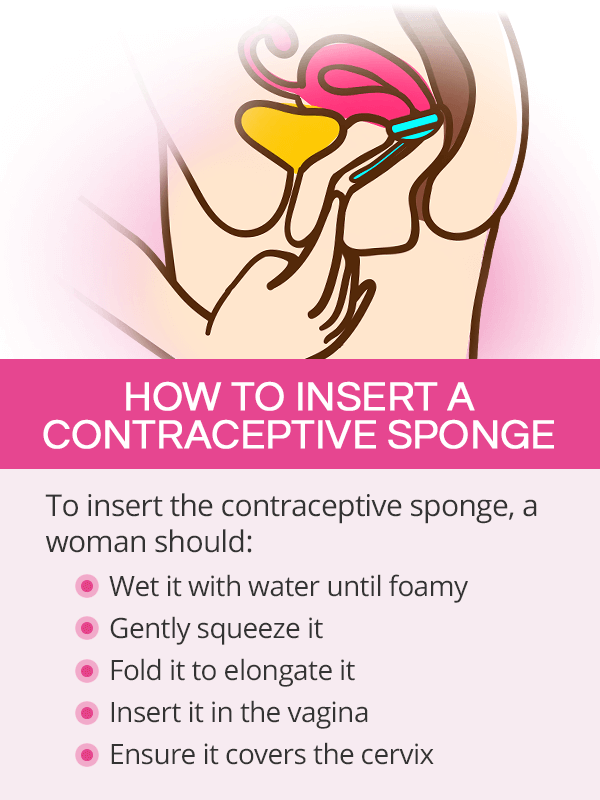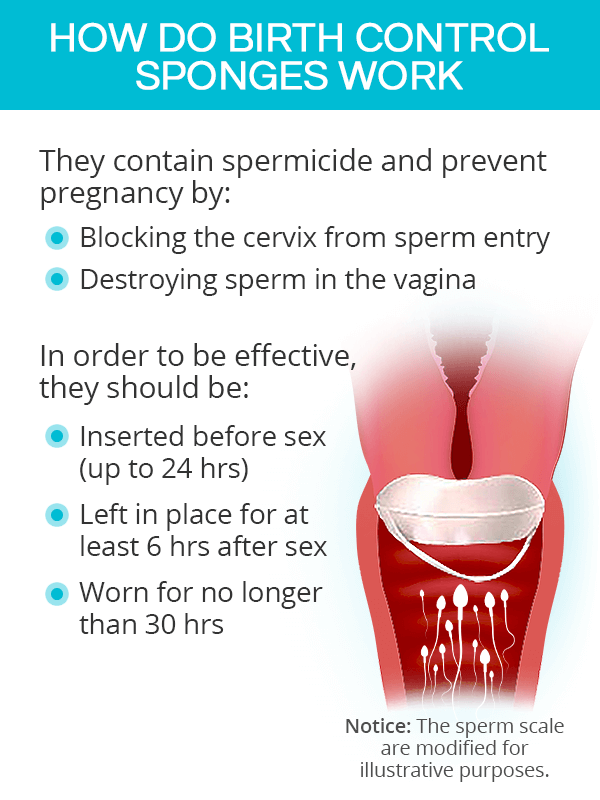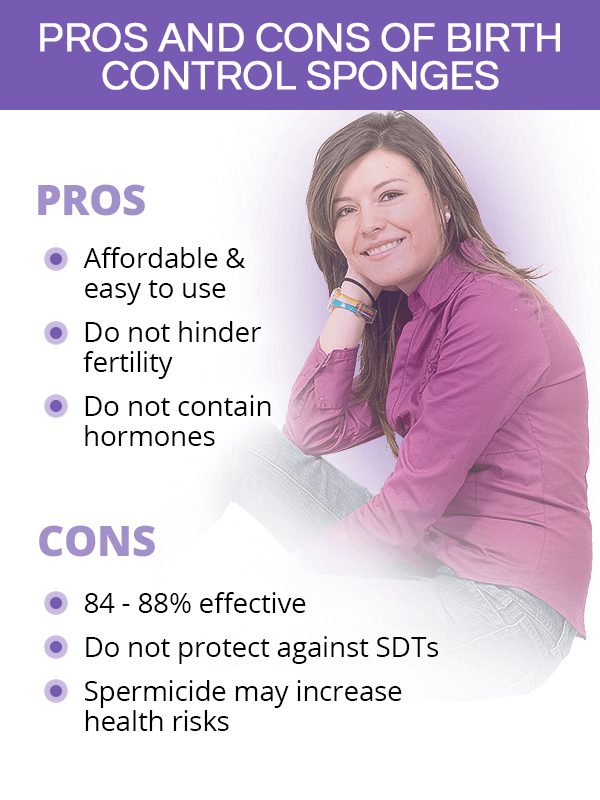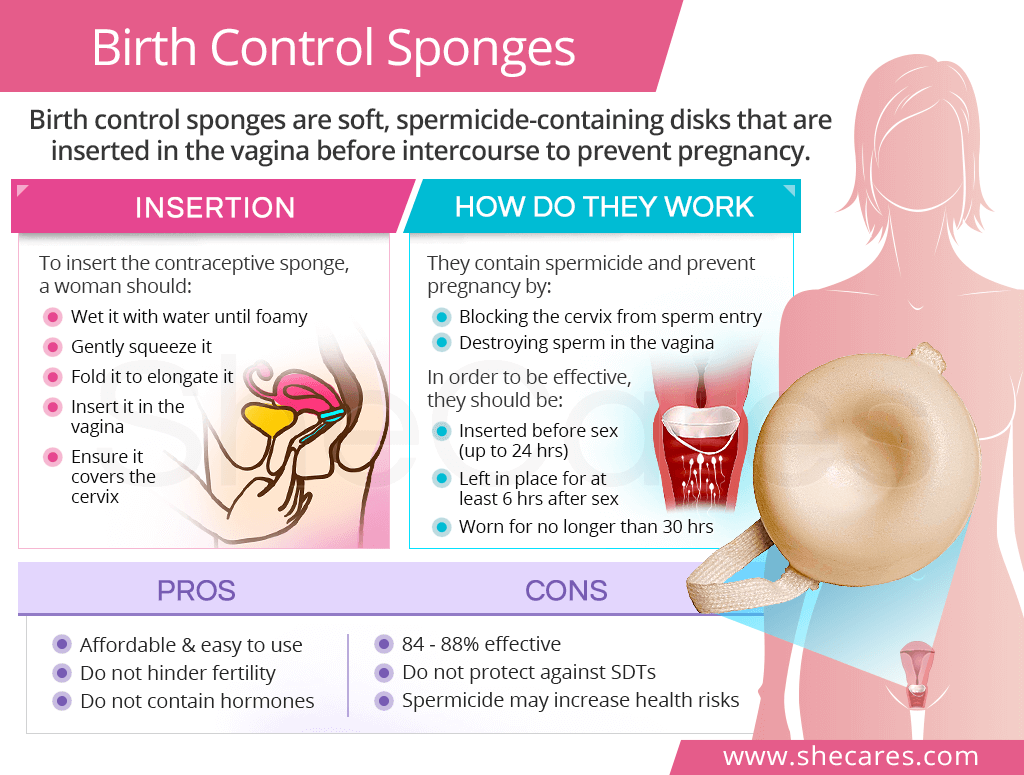About Birth Control Sponges
A birth control sponge is a soft, disk-shaped device that is used by women as a barrier method of contraception. It is also called a contraceptive sponge or, simply, the sponge.
Most contraceptive sponges on the market are made from polyurethane foam. There is a strap made of fabric attached to the bottom of the sponge for easy removal. It also contains spermicide.
There is only one FDA-approved brand of contraceptive sponges in the United States, called the Today Sponge. It is available for purchase over the counter. There are three sponges per package.
How to Insert a Contraceptive Sponge

Proper hand washing is key when inserting and removing a birth control sponge in order to ensure their safety and effectiveness.
The sponge must be inserted in the vagina each time a woman has sex, following these instructions:
- Take the sponge out of the package.
- Wet it with water so that it is completely wet and soapy to activate spermicide.
- Gently squeeze out excess water a little bit.
- Keeping the sponge's indented side up, fold it to elongate it.
- Insert the sponge into the vagina like tampons.
- Make sure the sponge has opened up and covers the cervix.
To remove the sponge, a woman should hook a finger around the loop and gently pull it out of the vagina. It should be discarded. Once taken out, the same sponge should never be inserted back into the vagina.
How do Birth Control Sponges Work

As the barrier method of birth control that contains spermicide, contraceptive sponges prevent pregnancy in the following two ways:
- They block sperm from accessing the cervix, preventing them from moving up the reproductive tract.
- Since they contain spermicide, they kill or slow down sperm to avoid its passage through the tract.
The sponge's effectiveness highly depends on whether a woman uses it correctly each time she has sex, observing the following instructions:1,2
- A contraceptive sponge can be inserted in the vagina up to 24 hours before intercourse.
- After sex, it should not be taken out for at least six hours.
- It should not be left in place for longer than 30 hours.
- A woman can have numerous intercourses within the 24-hour period, without taking it out.
The sponges should not be used during periods or by women with a history of toxic shock syndrome (TSS).
Pros and Cons of Birth Control Sponges

Contraceptive sponges come with a number of features that may be attractive to women seeking birth control. However, to use them to their advantage, women should be aware of their limitations.
Pros of Birth Control Sponges
- The sponges do not have any hindering effects on women's fertility.
- They are affordable, costing about $5 per sponge.3
- They can be purchased without doctor's prescription.
- They do not contain synthetic hormones, such as estrogen or progesterone.
Cons of Birth Control Sponges
- With perfect use, contraceptive sponges are 91% effective. With typical use, they are 84-88% effective.3,4
- Having had given birth may decrease the effectiveness even further.
- Sponges do not protect against sexually transmitted diseases (STDs).
- Nonoxynol-9, a chemical used in most spermicides, has been found to increase certain health risks.5
Key Takeaways
Birth control sponges are soft, disk-shaped devices placed in the vagina before each intercourse. They contain spermicide and prevent pregnancy by blocking the cervix and killing sperm. Also called contraceptive sponges, they offer women of all ages easy-to-use, on-the-go protection. Since a sponge can be inserted several hours before intercourse, it does not interrupt sex. Additionally, being hormone-free, they can be used by women who – for medical or personal reasons – do not want to rely on hormonal birth control. However, the sponges do not protect against STDs, and with typical use, they are 84 to 86% effective. For women who have given birth in the past, effectiveness may be further reduced. Yet, they are an affordable and convenient way to stay in control over one's reproductive future.
Sources
- American College of Obstetricians and Gynecologists. (2018). Barrier Methods of Birth Control Spermicide Condom Sponge Diaphragm and Cervical Cap. Retrieved October 5, 2020 from https://www.acog.org/womens-health/faqs/barrier-methods-of-birth-control-spermicide-condom-sponge-diaphragm-and-cervical-cap
- Summit Medical Group. (2014). Birth Control Sponge. Retrieved October 5, 2020 from https://www.summitmedicalgroup.com/library/adult_health/aha_birth_control_sponge/
- University of Florida Health. (2018). Vaginal sponge and spermicides. Retrieved October 5, 2020 from https://ufhealth.org/vaginal-sponge-and-spermicides
- University of Michigan. (2019). Contraceptive sponge for birth control. Retrieved October 5, 2020 from https://www.uofmhealth.org/health-library/tw9510
Footnotes:
- Mayo Clinic. (2019). Contraceptive sponge. Retrieved October 5, 2020 from https://www.mayoclinic.org/tests-procedures/contraceptive-sponge/about/pac-20384547
- Medline Plus. (2020). Vaginal sponge and spermicides. Retrieved October 5, 2020 from https://medlineplus.gov/ency/article/004003.htm
- Planned Parenthood. (n.d.). Birth Control Sponge. Retrieved October 5, 2020 from https://www.plannedparenthood.org/learn/birth-control/birth-control-sponge
- American Pregnancy Association. (2013). Contraceptive Sponge. Retrieved October 5, 2020 from https://americanpregnancy.org/unplanned-pregnancy/birth-control-pills-patches-and-devices/contraceptive-sponge-5036/
- Center for Young Women's health. (2020). Contraceptive Sponge. Retrieved October 5, 2020 from https://youngwomenshealth.org/2013/08/22/contraceptive-sponge/
